
AST Ascentia 950N
The AST Ascentia 950N is a Pentium-based laptop released by AST Computer in 1995. The Ascentia 950N was the last laptop that AST produced in-house. All following AST laptops would be manufactured by other companies.
The 950N's keyboard is a high-quality Lexmark buckling-sleeve unit, the same vendor that IBM sourced from for their ThinkPads. As such, a 950N keyboard should feel very nice to type on.
Critical Reception
The Ascentia 950N received generally mixed to positive reviews from the tech press. In an August 1995 review, PC Magazine praised the system for its high-resolution display, 16-but sound support, infrared support, and overall performance, but they criticised the system for poor text scaling outside of Windows and below-average disk performance. A January 1996 issue of PC World called the 950N a "strong contender" and a "good value in a power notebook", praising its performance, portability, and battery life. However, they noted that they found the trackpoint to be "difficult to manipulate efficiently", and they pointed out that 950N had suffered poor ratings in their recent reliability survey.
Specifications
| Spec | Details |
|---|---|
| CPU | Intel Pentium @75, 90, or 120MHz |
| RAM | 2x memory card slots, I believe proprietary - 8MB Standard - 40MB Maximum |
| Hard Disk | 2.5" IDE - 500MB, 800MB, or 1.2GB Standard - Uses proprietary adapter |
| Display Options | - 10.4" Passive Matrix Color @800x600 - 10.4" Active Matrix Color @800x600 - 11.8" Active Matrix Color @800x600 |
| Graphics Chipset | Cirrus Logic GD7543 - 1MB VRAM |
| Audio | Creative Labs Vibra 16 w/ Yamaha OPL3 |
| Main Battery | Lithium Ion, 1800mAH |
| CMOS Battery | - Soldered Lithium Ion CMOS Battery - Varta NiMH 6-cell Reserve Battery |
| Power Supply | Barrel Jack, 18V 1.9A |
| Disk Drives | 3.5" 1.44MB Floppy Drive |
| PC Cards | 2x PCMCIA slots |
| Networking | None Internal |
| Other I/O | - 1x Serial - 1x Parallel - 1x VGA Out - 1x PS/2 - 1x Line In - Line Out - Infrared |
| BIOS | AST BIOS |
| Pointing Device | TrackPoint |
Resources
 Brochure |
 Drivers |
|---|
Common Faults & Maintenance
The Ascentia 950N suffers from many known failures that affect many laptops from its time, including battery leaks and plastic issues. Beyond this though, the 950N has gained a very poor reputation in general, based on comments that David Murrary from The 8-Bit Guy YouTube Channel spoke about the laptop while giving a presentation on his time working for AST. This page will go into that and more.
The 8-Bit Guy's claims
In his presentation (that he later uploaded to YouTube), David used the 950N as an example of the declining quality of AST's products. He said that these laptops would have frequent screen failures, plastic parts breaking, other problems, and even battery fires. He stated that the 950N managed to achieve a return rate of around 110%! I don't really doubt these claims because I have little reason to, but what I can say is that I've found a few YouTube videos, and also a forum post showing these working. So at the very least, they're not all dead. My best guess is that David was correct, and that AST likely fixed the production issues causing these failures eventually, replaced most of the bad units, and then the fixed ones were likely pretty decent, reliability-wise, when new. Apple had a very similar situation with initial quality issues with the PowerBook 5300, and the later "fixed" units are no more unreliable than any other laptop from the time. I can somewhat reinforce this theory based on testimony I've heard from a user on the VCF forums, who used one of these for over a decade as a work computer, and had zero issues. He also reported that he didn't remember any major complaints from the other people at his job that also used them.
However, they certainly are provably prone to failure today, for reasons due to time rather than poor initial quality. Not saying initial quality was good on these, just that other time-related issues are now rearing their ugly heads. Let's talk about those known issues.
Battery Leaks
The 950N has an internal VARTA NiMH 6-coin-cell battery located in the upper top left of the laptop. It was likely used as a hiberation battery as these also had a coin cell Lithium battery for backing up the CMOS. These sorts of batteries are incredibly prone to leaking with time, and a large quantity of 950Ns have likely fallen victim to corrosion from these batteries. The battery in this unit is placed directly near critical components. This battery should be removed ASAP in any unit to prevent damage.
Brittle Plastics & Hinge Failures
Like nearly any other 90s laptop, the 950N's plastic is quite brittle with age. Most I see show up for sale have stress cracks around the display hinge mounts. You may need to do some ugly epoxy work to keep one of these intact.
RetroSpector78's Videos
YouTuber RetroSpector78 has made two videos on the 950N, documenting his attempts at getting one working out of a bunch of parts he had. He did manage to produce one working laptop in the end, but encountered trouble along the way. Mainly, multiple motherboards would simply fail to power on most of the time, only sometimes making it to POST. He also encountered at least one leaking VARTA battery, and broken plastic around the display hinges. The power issues were not related to any bad capacitors and had an unknown cause. Notably, all of his motherboards had significant rework done on them, likely either from the factory or from AST servicing them after purchase.
Other Notes
Like any other laptop of its time, the screens on the 950N can get Vinegar Syndrome.
You may want to remove or tape over the contacts of the Lithium Ion battery out of a 950N if you have one, just in case, considering the report of fires.
I've seen one of these that looked like the top of the trackpoint cap was missing. It likely turned to goo and then fell apart when someone tried to use it, as can be common in certain early TrackPoint caps, as rubber ages. Just something to keep in mind.
Gallery
Images on this page were provided by RetroSpector78 on YouTube - thank you for giving me permission to use these! All images (except the first one) are stills from his two videos on the 950N.
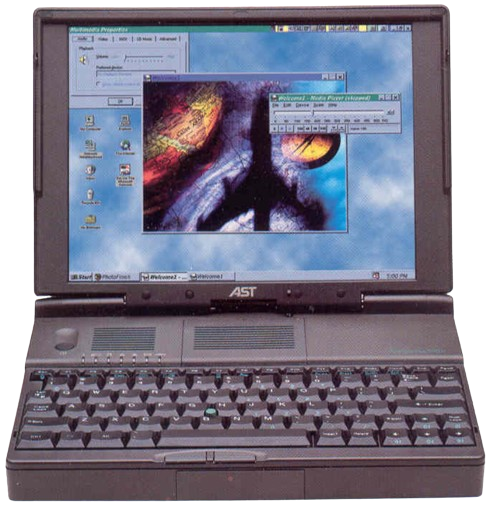
Ascentia 950N with the rare high-end 11.8" LCD option.
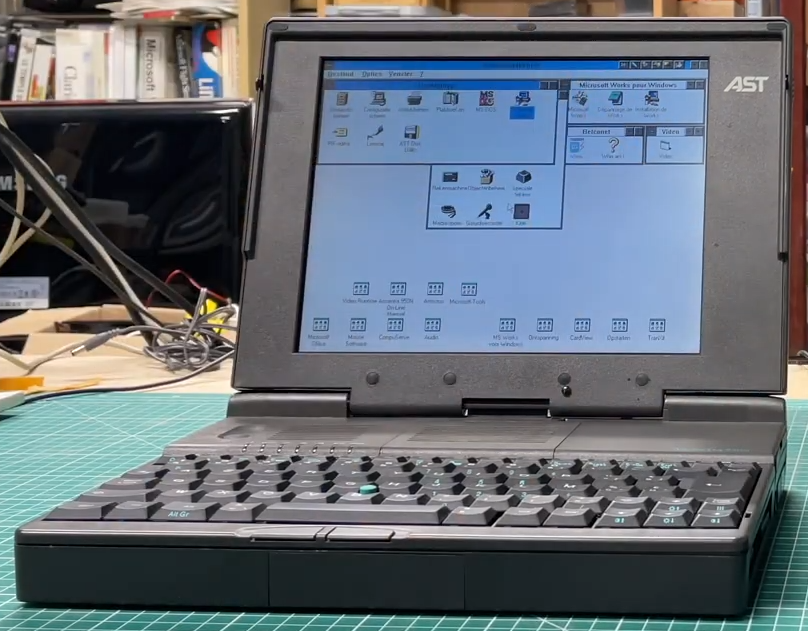
Ascentia 950N with 10.4" TFT LCD.
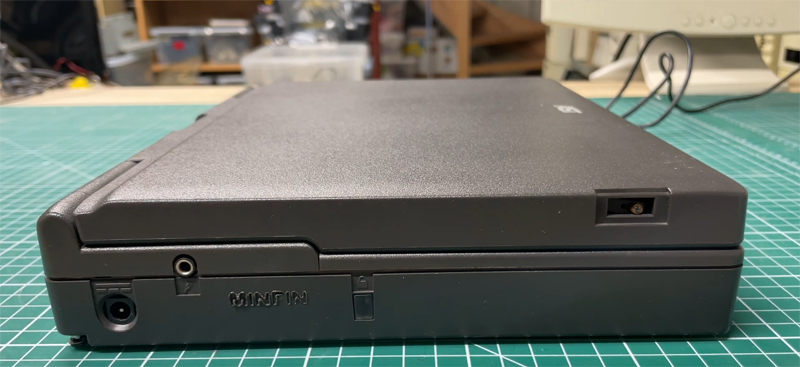
Left side, this one having a branding etched into it.
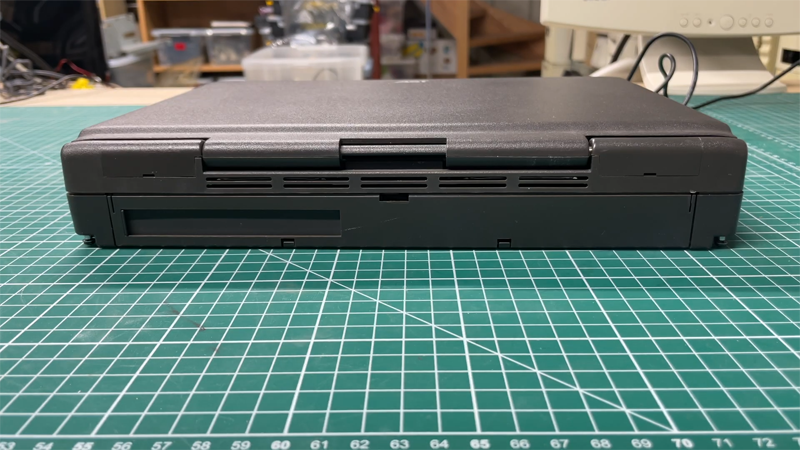
Rear side.
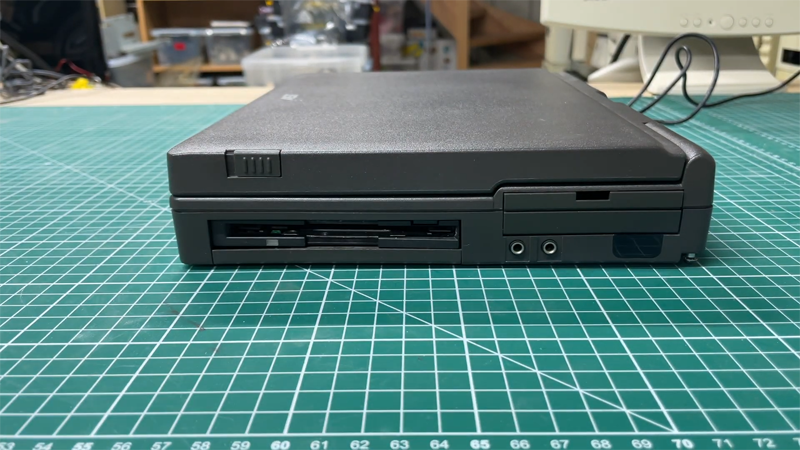
Right side, with the unit's floppy drive (Panasonic), PC Card slots, IR, and audio jacks.
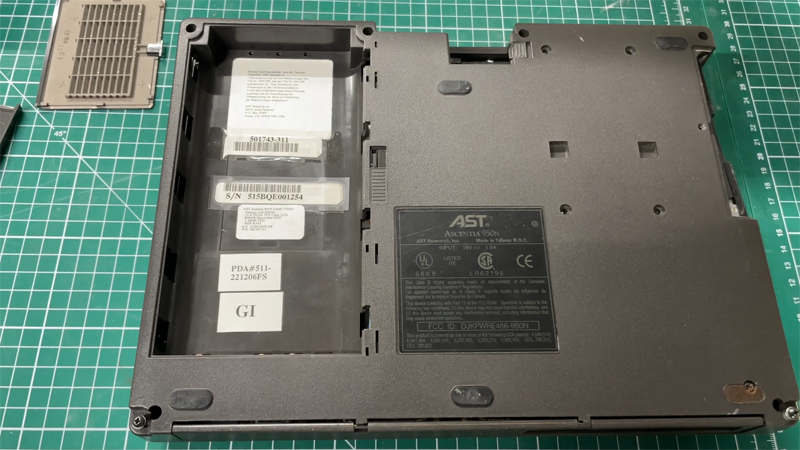
Bottom of the 950N.
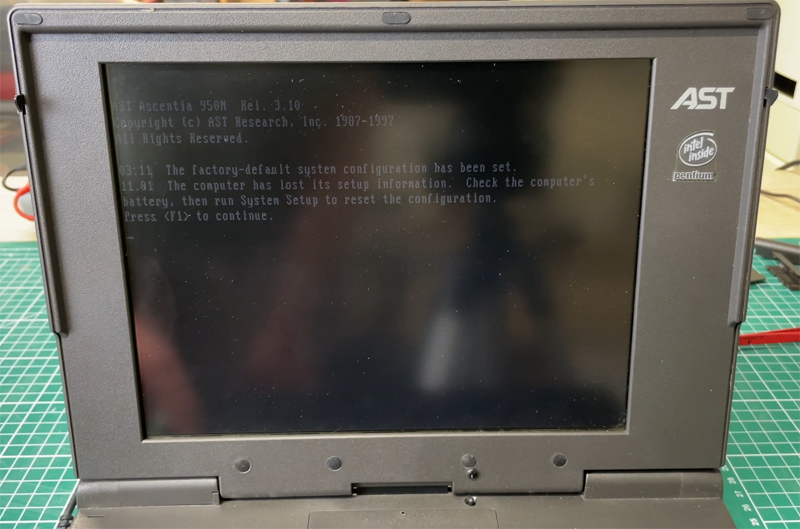
BIOS POST screen.
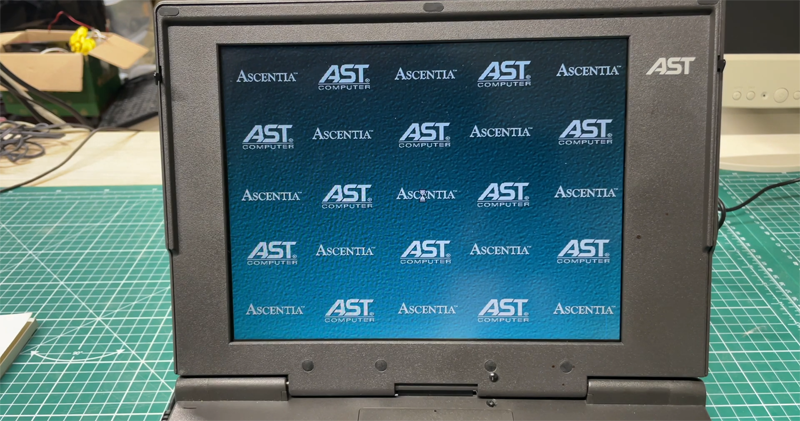
Custom AST wallpaper.
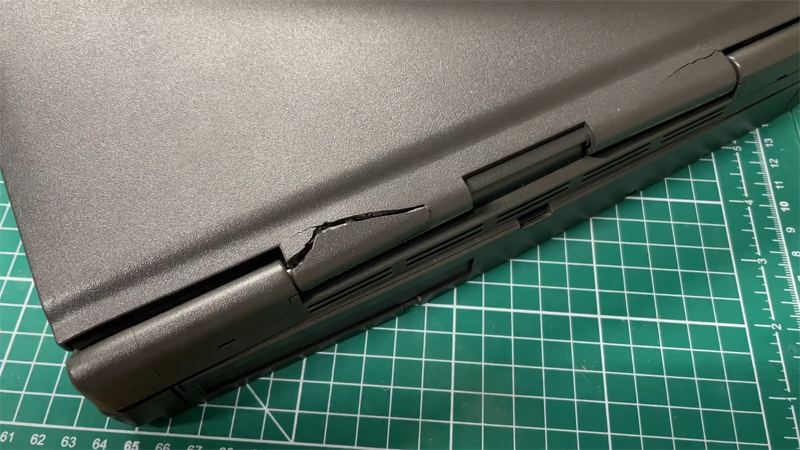
Plastic structural failure around the display hinges, a typical failure on laptops from the 1990s. This will eventually affect every 950N.
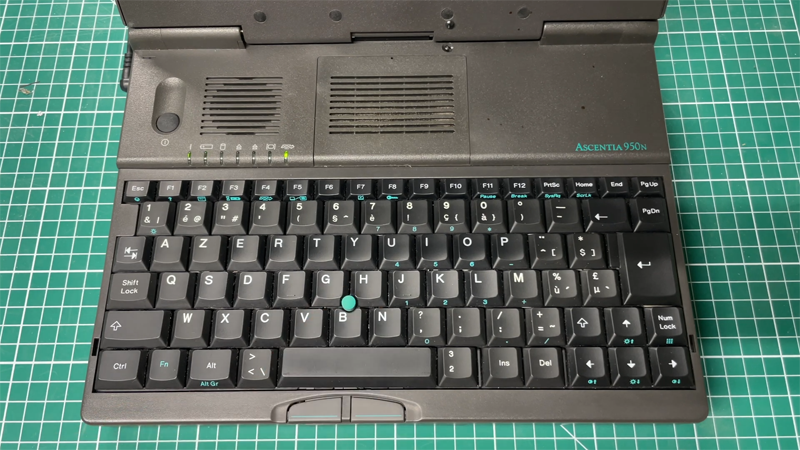
Base half of the unit.
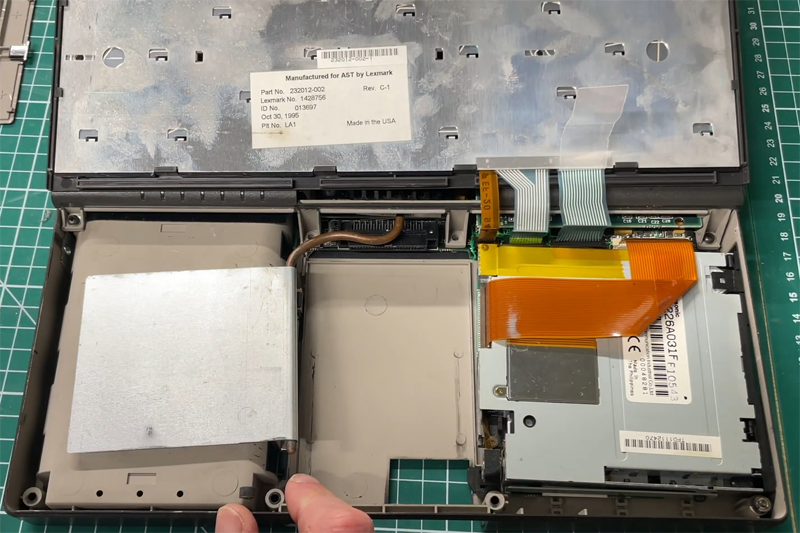
Keyboard lifted. From left to right: Battery bay, hard drive bay, floppy disk drive.
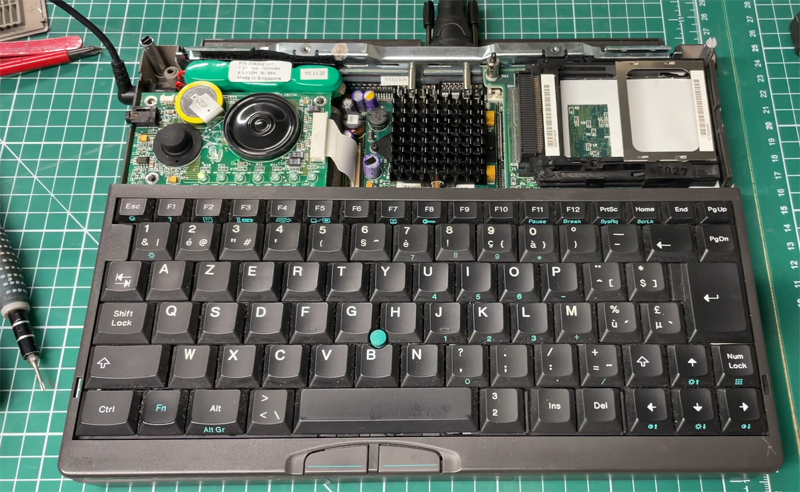
LCD assembly and keyboard surround removed.
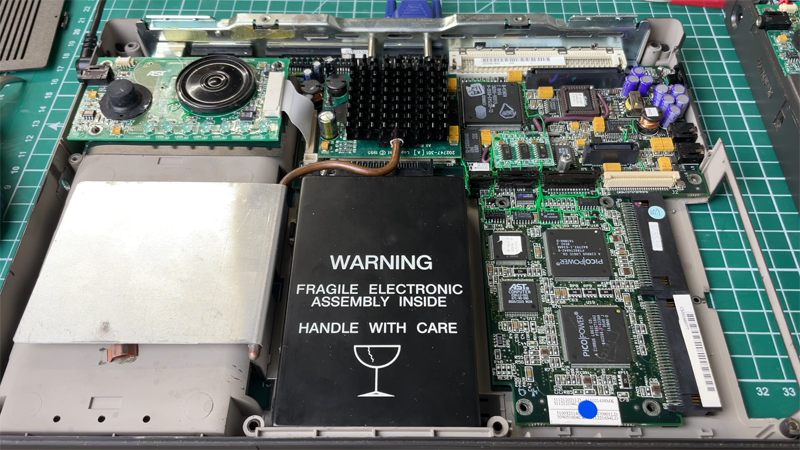
Both parts removed.
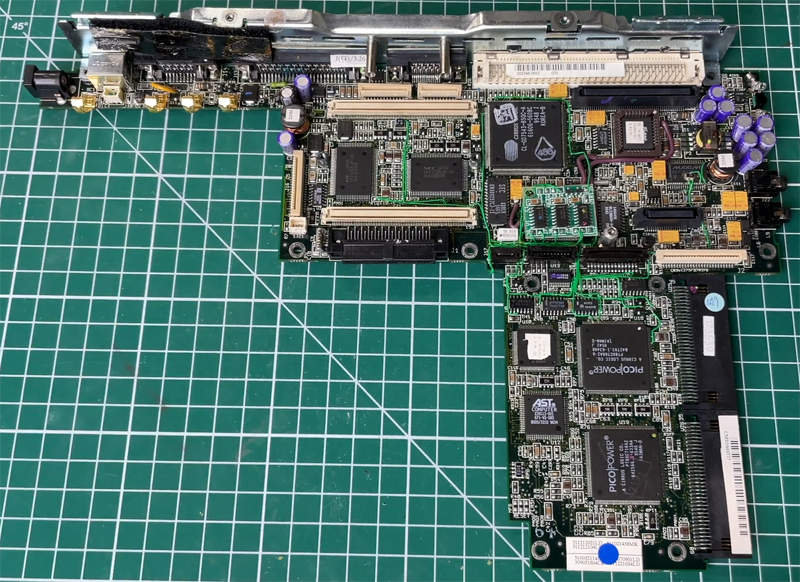
Ascentia 950N motherboard, top view.
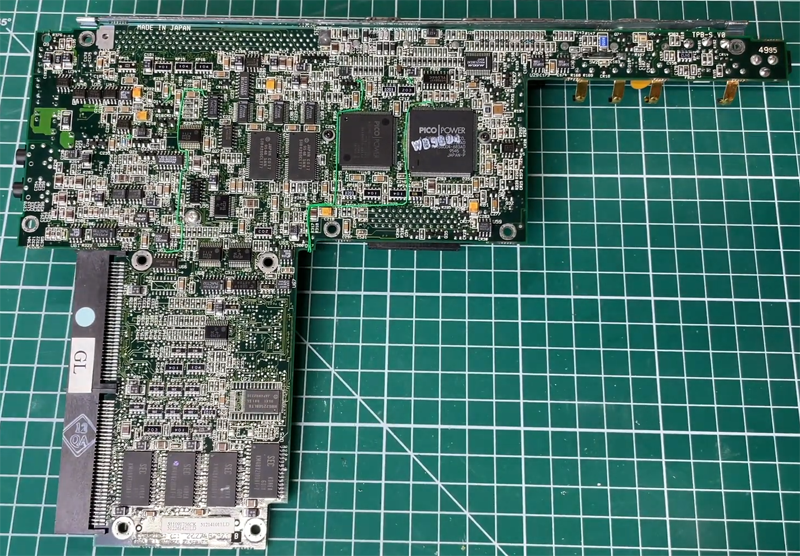
Ascentia 950N motherboard, bottom view.
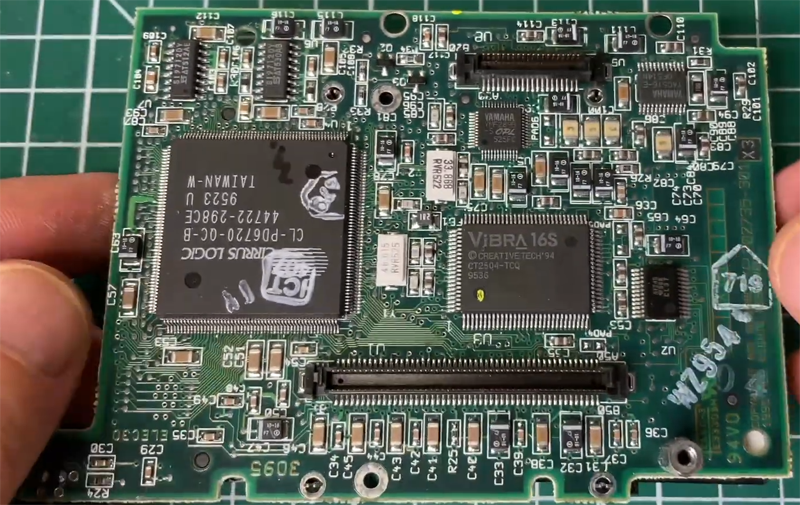
Bottom side of the PCMCIA sub-board, which also includes the 950N's Vibra 16 sound chip. Note the real Yamaha OPL chip sitting above the main Creative chip.
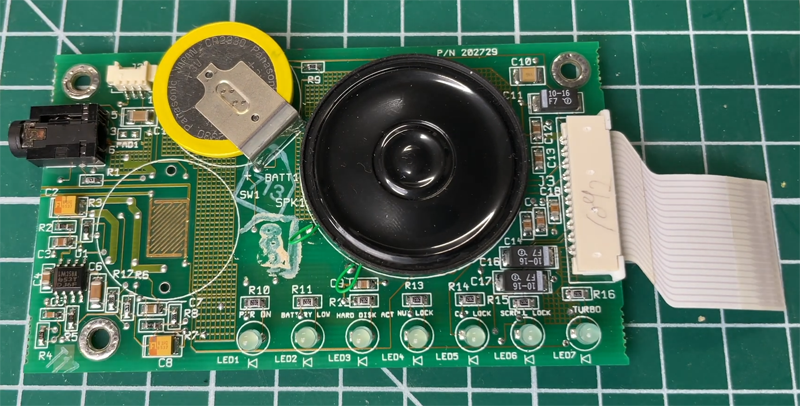
Sub-Board, includes the CMOS battery, power button (contact pad below the battery), LEDs, and the speaker.
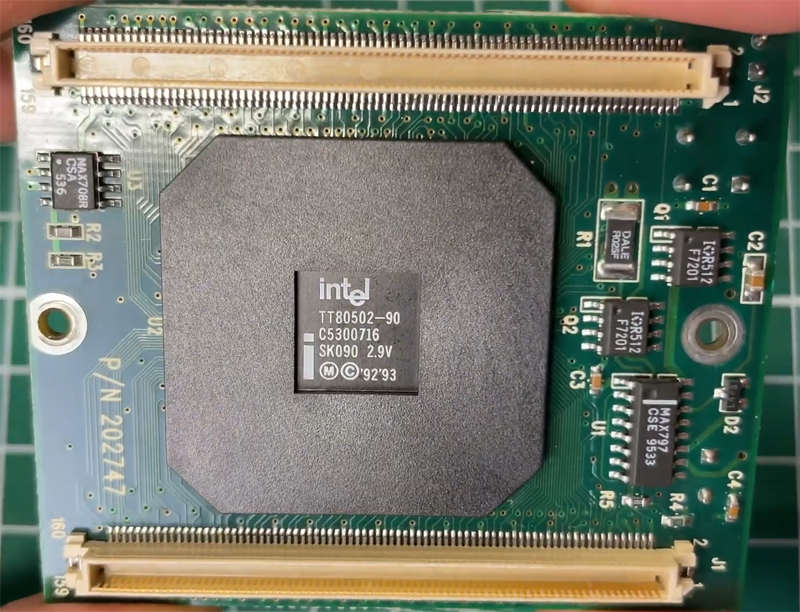
CPU daughtercard, side facing the motherboard. The 950N uses a special mobile Pentium. The CPU itself is soldered. You need to find another full daughtercard in order to upgrade.

Side of the CPU card facing up. The card goes under the door above the center of the keyboard. This is the side where the heat sink is attached. The 950N's heatsink uses a copper heat pipe, but according to AST's technical bulletins, 950Ns still had overheating issues.

Keyboard unit.

VARTA 6-cell battery using V110H cells. This battery is used to keep the laptop alive in suspend mode while the main battery is swapped to a spare. This battery is extremely likely to leak and should be removed from any 950N.
Page last updated (MM/DD/YYYY): 09/18/2024
Update Reason: pages consolidated
Back-Navigation
Index < Laptop Portal < AST < Ascentia 950N